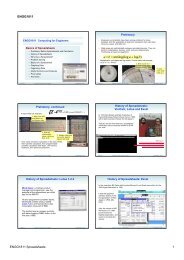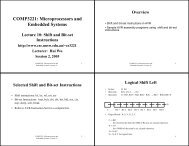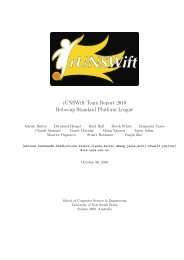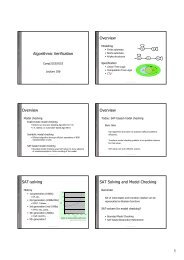Dual-pipeline heterogeneous ASIP design - School of Computer ...
Dual-pipeline heterogeneous ASIP design - School of Computer ...
Dual-pipeline heterogeneous ASIP design - School of Computer ...
Create successful ePaper yourself
Turn your PDF publications into a flip-book with our unique Google optimized e-Paper software.
~<br />
tiou <strong>of</strong> instruction generation and <strong>design</strong> space exploration<br />
tools. In [4, 17, 221 tool suites take a specification (written<br />
in an architectural description language) and generate re-<br />
targetable compilers, instruction set simulators (ISS) <strong>of</strong> the<br />
target architecture, and synthesisable HDL models <strong>of</strong> the<br />
target processor. The generated tools allow valid assembly<br />
code generation and performance estimation for each spec-<br />
ified architecture. In [21] the <strong>design</strong> flow consists <strong>of</strong> gener-<br />
ating instructions automatically, inserting instructions, and<br />
performing a heuristic <strong>design</strong> space exploration. Automatic<br />
instruction generation locates the regular templates derived<br />
~~ ~~~~ ~~~~~ ~~~~<br />
~ ~~~ ~<br />
are rankkd, and thi hyghest ranking blocks are imple&nt'ed<br />
as instructions.<br />
In [6], the authors searched for regularity in sequential,<br />
parallel and combined sequential/parallel hasic instructions<br />
in a dataflow graph. New sets <strong>of</strong> instructions were gener-<br />
ated by combining basic instructions. Kastner et al. in [14]<br />
searched for an optimal cover <strong>of</strong> a set <strong>of</strong> regular instructions,<br />
and then constructed an optimal set <strong>of</strong> sequential instruc-<br />
tions. Zhao et al. in [23] used static resource models to<br />
explore possible new instructions that can be added to the<br />
data path to enhance erformance.<br />
A system called PEAS-I11 for the creation <strong>of</strong> <strong>pipeline</strong>d<br />
<strong>ASIP</strong>s is described in [16]. A parallel and scalable <strong>ASIP</strong> ar-<br />
chitecture suitable for reactive systems is described in [19].<br />
A novel approach to select the Intellectual Properties (IP)<br />
and interfaces for an <strong>ASIP</strong> core to accelerate the applica-<br />
tion is proposed in [7]. A Hardwarels<strong>of</strong>tware partitioning<br />
algorithm for automatic synthesis <strong>of</strong> a <strong>pipeline</strong>d <strong>ASIP</strong> with<br />
multiple identical functional units with area constraints is<br />
introduced in [5]. The code generation for time critical loops<br />
for Very Large Instruction Word (VLIW) <strong>ASIP</strong>s with het-<br />
erogenous distributed register structure is addressed in [ll].<br />
In 1121 a methodolow for earlv snace exoloration af VLIW<br />
architecture is presented in [9]. In[S] using power estimation<br />
techniques from high level synthesis, a low power <strong>ASIP</strong> is<br />
synthesized from a customized ASIC. Case study <strong>of</strong> power<br />
reduction is given in [lo]. Evaluation <strong>of</strong> the effect <strong>of</strong> register<br />
file size in <strong>ASIP</strong> performance and power is done in (131.<br />
In 1151, Kathail et al. proposed a <strong>design</strong> flow for a VLIW<br />
processor consisting <strong>of</strong> a selection <strong>of</strong> Non-Programmable<br />
hardware Accelerators (NPAs), <strong>design</strong> space exploration <strong>of</strong><br />
implementing different combinations <strong>of</strong> NPAs, and evaluation<br />
<strong>of</strong> the <strong>design</strong>s. An NPA is a co-processor for functions<br />
expressed as compute-intensive nested loops in C.<br />
In [20] the author discusses a decoupled Access/Execute<br />
architecture, with two computation units containing own<br />
instruction streams. The processor decouples data accesses<br />
and execution (for example ALU instructions). One <strong>of</strong> them<br />
does all the memory operations, while both can perform<br />
non-memory access operations. The architecture issues two<br />
instructions per clock cycle. The two instruction streams<br />
communicate via architectural queues.<br />
Our architecture is somewhat similar to the one proposed<br />
in [20]. We customise the processor for a particular application,<br />
while the processor in [20] is generic. They use separate<br />
register files for each pipe, with a common copy area. We<br />
use a global register file. We also avoid an instruction queue,<br />
preferring a compile time schedule <strong>of</strong> instructions and avoid<br />
data hazards by inserting NOPs appropriately.<br />
1.3 Contributions<br />
For the first time we create a dual <strong>pipeline</strong> <strong>ASIP</strong> and<br />
demonstrate that it is feasible to utilize such a processor to<br />
extend the <strong>design</strong> space <strong>of</strong> an application. In particular:<br />
13<br />
a simple <strong>heterogeneous</strong> architecture has been proposed<br />
with data access instructions allocated to one pipe,<br />
instruction fetch and branch instructions allocated to<br />
the other pipe, and all other instructions implemented<br />
on one or both pipes (note we have an ALU on one<br />
pipe, and if necessary some <strong>of</strong> the operations within<br />
the ALU can be duplicated on the other);<br />
and, a methodology containing an algorithm with poly-<br />
nomial complexity has been proposed to determine<br />
which instructions should he in both pipes.<br />
1.4 _Paoer _ Organizatinn<br />
~~ ~~<br />
The rest <strong>of</strong> the paper is organized in the following way.<br />
Section 2 describes the architecture template <strong>of</strong> the dual<br />
nioeline Drocessor to be imolemented. The ~~~~ followine ~~~~~<br />
secii&<br />
desciibes the methodoldgy taken to <strong>design</strong> dual $&%ne<br />
processor. Simulations and results are given in section 4. Finally,<br />
the paper is concluded in section 5.<br />
2. ARCHITECTURE<br />
Our goal is to <strong>design</strong> an application-specific dual <strong>pipeline</strong><br />
processor to improve performance, reduce energy consump-<br />
tion with minimal area penalty.<br />
The architecture template adopted is shown in Figure 1.<br />
.I REGlSTERFlLE I.<br />
I I<br />
Figure 1: Architecture Template<br />
The two-pi eline rocessor has two functional data paths.<br />
Both paths &are de same register file, data memory and<br />
instruction memort The register file has two-ports to enable<br />
data traffic on bot <strong>pipeline</strong> paths at the same time.<br />
The control unit &-one orthe <strong>pipeline</strong>s, controls the instruction<br />
fetch from the instruction memory and dispatches<br />
instructions to both paths. The other path controls data<br />
memory access to transfer data between register file and<br />
data memory. Each path has a separate control unit that<br />
controls the oDeratiou <strong>of</strong> the ~ related ~ ~~~ ~~ functional units on that<br />
path. We sepirate the instruction fetch and data fetch into<br />
two separate pipes to reduce the controller complexity. Some<br />
instructions will appear on both paths. The functional units<br />
in each path are determined by the instruction set desianed<br />
is possible to execute two add instructions simultaneously,<br />
one hy the ALU on the left and one on the adder on the<br />
right. A methodolo for determining the functional units<br />
that havr ~~~ ~ to ~ be dunKatrd ~~ ~~~~ is ~~ riven in section 3.<br />
Based on the arhitectnre, attempt:<br />
to efficiently exploit parallelism by dual <strong>pipeline</strong>s;











